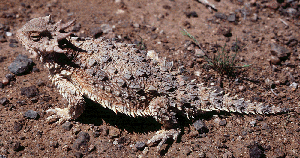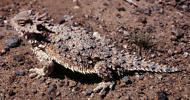Phrynosomatidae
Kevin de Queiroz and Tod Reeder


This tree diagram shows the relationships between several groups of organisms.
The root of the current tree connects the organisms featured in this tree to their containing group and the rest of the Tree of Life. The basal branching point in the tree represents the ancestor of the other groups in the tree. This ancestor diversified over time into several descendent subgroups, which are represented as internal nodes and terminal taxa to the right.

You can click on the root to travel down the Tree of Life all the way to the root of all Life, and you can click on the names of descendent subgroups to travel up the Tree of Life all the way to individual species.
For more information on ToL tree formatting, please see Interpreting the Tree or Classification. To learn more about phylogenetic trees, please visit our Phylogenetic Biology pages.
close boxReferences
Blackburn, D.G. 1978. The comparative, functional, and evolutionary myology of burrowing sceloporine lizards. Master's Thesis, Cornell University.
Burt, C.E. 1935. A key to the lizards of the United States and Canada. Trans. Kans. Acad. Sci. 38:255-305.
Carpenter, C.C. 1963. A comparison of the patterns of display of Urosaurus, Uta, and Streptosaurus. Herpetologica 18:145-152.
Cope, E.D. 1900. The crocodilians, lizards, and snakes of North America. Smithson. Inst. Ann. Rep. 1898:153-1294.
de Queiroz, K. 1982. The scleral ossicles of sceloporine iguanids: A reexamination with comments on their phylogenetic significance. Herpetologica 38:302-311.
Etheridge, R. 1964. The skeletal morphology and systematic relationships of sceloporine lizards. Copeia 1964:610-631.
Etheridge, R., and K. de Queiroz. 1988. A phylogeny of Iguanidae. Pages 283-367 in R. Estes and G. Pregill, eds. Phylogenetic relationships of the lizard families. Essays commemorating Charles L. Camp Stanford University Press, Stanford, California.
Fanghella, C., D.F. Avery, and W.W. Tanner. 1975. Urosaurus and its phylogenetic relationship to Uta as determined by osteology and myology (Reptilia: Iguanidae). Great Basin Nat. 35:245-268.
Frost, D.R., and R. Etheridge. 1989. A phylogenetic analysis and taxonomy of iguanian lizards (Reptilia: Squamata). Univ. Kans. Mus. Nat. Hist. Misc. Publ. 81:1-65.
Hotton, N.I. 1955. A survey of adaptive relationships of dentition to diet in the North American Iguanidae. Am. Midl. Nat. 53:88-114.
Larsen, K.R., and W.W. Tanner. 1975. Evolution of the sceloporine lizards (Iguanidae). Great Basin Nat. 35:1-20.
Mittleman, M.B. 1942. A summary of the iguanid genus Urosaurus. Bull. Mus. Comp. Zool. Harvard 91:106-181.
Paull, D., E.E. Williams, and W.P. Hall. 1976. Lizard karyotypes from the Galapagos Islands: Chromosomes in phylogeny and evolution. Breviora (441):1-31.
Porter, C.A., M.W. Haiduk, and K. de Queiroz. 1994. Evolution and phylogenetic significance of ribosomal gene location in chromosomes of squamate reptiles. Copeia 1994:302-313.
Presch, W. 1969. Evolutionary osteology and relationships of the horned lizard genus Phrynosoma (Family Iguanidae). Copeia 1969:250-275.
Reeder, T.W. 1995. Phylogenetic relationships among phrynosomatid lizards as inferred from mitochondrial ribosomal DNA sequences: Substitutional bias and information content of transitions relative to transversions. Mol. Phyl. Evol. 4:203-222.
Savage, J.M. 1958. The iguanid lizard genera Urosaurus and Uta, with remarks on related groups. Zoologica 43:41-54.
Schmidt, K.P. 1953. A check list of North American amphibians and reptiles Sixth ed., American Society of Ichthyologists and Herpetologists.
Smith, H.M. 1946. Handbook of lizards. Lizards of the United States and Canada Cornell University Press, Ithaca, New York.
Stebbins, R.C. 1954. Amphibians and reptiles of western North America McGraw-Hill, New York.
Wiens, J.J. 1993. Phylogenetic relationships of phrynosomatid lizards and monophyly of the Sceloporus Group. Copeia 1993:287-299.
Wyles, J.S. and G.C. Gorman. 1978. Close relationship between the lizard genus Sator and Sceloporus utiformis (Reptilia, Lacertilia, Iguanidae): Electrophoretic and immunological evidence. J. Herpetol. 12:343-350.
Title Illustrations

| Scientific Name | Phrynosoma |
|---|---|
| Specimen Condition | Live Specimen |
| Image Use |
 This media file is licensed under the Creative Commons Attribution-NonCommercial-ShareAlike License - Version 3.0. This media file is licensed under the Creative Commons Attribution-NonCommercial-ShareAlike License - Version 3.0.
|
| Copyright |
© Kevin de Queiroz

|
About This Page
Kevin de Queiroz

Smithsonian National Museum of Natural History, Washington, D. C., USA
Tod Reeder

San Diego State University, San Diego, California, USA
Correspondence regarding this page should be directed to Kevin de Queiroz at
Page copyright © 1996 Kevin de Queiroz
 Page: Tree of Life
Phrynosomatidae.
Authored by
Kevin de Queiroz and Tod Reeder.
The TEXT of this page is licensed under the
Creative Commons Attribution-NonCommercial-ShareAlike License - Version 3.0. Note that images and other media
featured on this page are each governed by their own license, and they may or may not be available
for reuse. Click on an image or a media link to access the media data window, which provides the
relevant licensing information. For the general terms and conditions of ToL material reuse and
redistribution, please see the Tree of Life Copyright
Policies.
Page: Tree of Life
Phrynosomatidae.
Authored by
Kevin de Queiroz and Tod Reeder.
The TEXT of this page is licensed under the
Creative Commons Attribution-NonCommercial-ShareAlike License - Version 3.0. Note that images and other media
featured on this page are each governed by their own license, and they may or may not be available
for reuse. Click on an image or a media link to access the media data window, which provides the
relevant licensing information. For the general terms and conditions of ToL material reuse and
redistribution, please see the Tree of Life Copyright
Policies.
Citing this page:
de Queiroz, Kevin and Tod Reeder. 1996. Phrynosomatidae. Version 01 January 1996 (temporary). http://tolweb.org/Phrynosomatidae/17587/1996.01.01 in The Tree of Life Web Project, http://tolweb.org/







 Go to quick links
Go to quick search
Go to navigation for this section of the ToL site
Go to detailed links for the ToL site
Go to quick links
Go to quick search
Go to navigation for this section of the ToL site
Go to detailed links for the ToL site